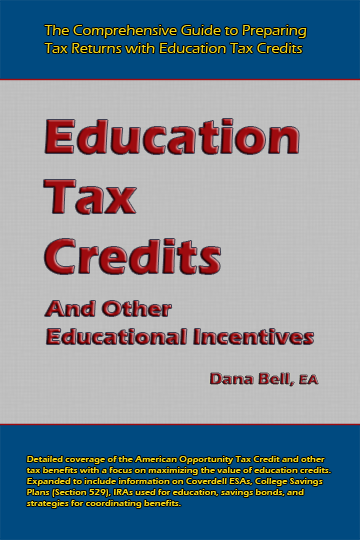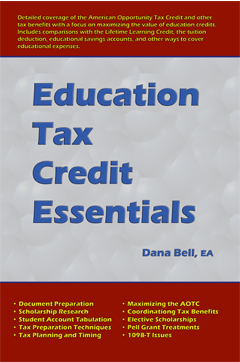Education Tax Credits
Education Tax Credits is a guide for tax professionals to better understand the many complexities related to education tax credits and other tax incentives for education. This systematic analysis guides preparers in the steps required to process education credit claims, from researching scholarships and calculating the maximum credit to coordinating with educational savings accounts and Pell grants.
Beginning with an overview of education credits it then discusses treasury regulations, types of scholarships, scholarship treatments, and scholarship research. This book also discusses 1098T reporting rules, coordinating tax benefits, and tax planning. Illustrated aids assist in document preparation and student account tabulation with examples of records from two local institutions.
The AOTC worksheet included is instrumental in calculating the maximum credit and a collection of tax preparation techniques are discussed to simplify credit calculations based on individual circumstances. A section on software solutions also shows recommended steps for claiming the credit in some of the major tax software systems.
Planning includes a discussion of claiming strategies and coordination with other forms of educational assistance, amending returns to claim the credit for prior years, and coordinating tax returns for family members when there is a education credit claim. Some special issues discussed include AGI considerations, AOTC phase-outs, changes in EITC, common errors, and a discussion of alternate treatments. Additional advice is given to help to insure that returns with education credits clearly comply with tax law and regulations and can be documented.
Additional sections cover other educational incentives, such as Educational Savings (Section 529 and Coverdell), UTMA considerations, IRAs used for education, and employer assistance. There is also a section discussing financial aid and the relationship with tax benefits, and student loans.
The book comes at a time when there are mixed signals from Washington about education credits. While the IRS and Treasury Department has been promoting the use of treasury regulations to increase the refund amount available with a claim, the Treasury Inspector General for Tax Administration (TIGTA) is saying there may be potentially billions in education credit fraud, and now restrictions have been added to the AOTC that could deprive some taxpayers of the credit. A final chapter takes a look at the future of tax credits.
Alert: One of the premises of this book was that taxpayers do not have to have a 1098-T in order to claim an education credit. While that is no longer the case, the IRS is providing a reprieve until regulations are finalized that would require institutions to provide 1098-T to all students. The new law was passed June 29, 2015 as part of the Trade Preferences Extension Act of 2015 and added the requirement to IRC § 25A(g)(8). Until the proposed regulations are final, a taxpayer may claim an education credit provided they are otherwise eligible. https://www.irs.gov/irb/2016-33_IRB/ar11.html.
About the Author
Dana Bell received his Enrolled Agent designation in 2014 and has degrees in Accounting and Computer Information Systems. He graduated summa cum laude from the University of Texas at Tyler in 2012. He currently maintains a blog at www.tylerhosting.com/b2e called Switched Keys where several topics in this book were first posted. In addition to writing about tax accounting and business, Dana is a computer programmer, website developer and host, database guru, and graphic designer (Adobe Certified Expert). During the past few tax seasons he also volunteered as a VITA tax preparer and quality reviewer and as a Tax-Aide counselor. Favorite pastimes include disc golf, photography, chess, and Scrabble™.
Also Available
Education Tax Credit Essentials is an abbreviated version of Education Tax Credits. The Essentials version attempts to help professionals better understand the many complexities related to education tax credits and other tax incentives for education. This systematic analysis guides preparers in the steps required to process education credit claims, from researching scholarships and calculating the maximum credit to coordinating with educational savings accounts and Pell grants.




